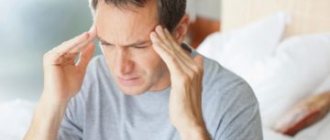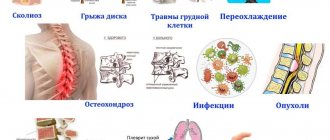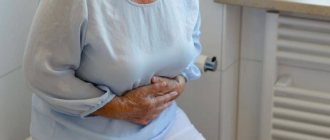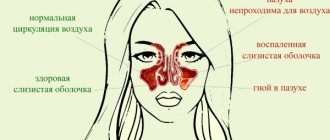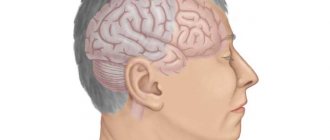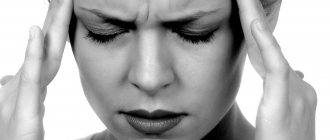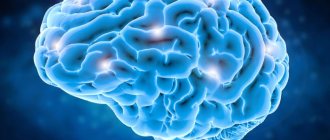Symptoms of nervous chest pain are as follows:
- the pain may be distributed throughout the chest and may not be severe, but long-lasting;
- can be sharp, shooting, piercing, radiating to the stomach;
- can be localized strictly in one place;
- you can feel how tense the muscles in the chest area are, sometimes their spasm is clearly noticeable;
- burning or numbness in the chest area;
- pressure on the chest and tightness inside it;
- feeling of fullness;
- migration of pain to the back and its return back.
Psychogenic chest pain can haunt an anxious person constantly, or it can be a rather rare episode in his life. At the same time, the same individual may have periods in life when pain in the chest does not go away, or there may be periods of calm that last days, weeks, months.
Chest pain can complement other symptoms of VSD or manifest itself in splendid isolation. They can begin after some stressful event or before it, or they can come as if out of nowhere.
Painful sensations tend to intensify at the moment when the neurotic person is not busy with anything, for example, he went to bed and felt fully himself. Quite often, increased pain in the chest area is observed after eating, especially a large meal.
Why does my back hurt due to nervousness and how to get rid of it?
Today, on the website of abstracts of dissertations in psychology, you can find many scientific works that are devoted to the problem of physical symptoms in chronic nervous tension and anxiety. That is, the condition that is still often called vegetative-vascular dystonia (VSD).
Most neurotic patients complain of back pain.
Symptoms of psychogenic back pain
- Back pain that occurs due to nerves can be quite severe. Often people even take painkillers, especially at night, because they cannot sleep due to discomfort.
- Pain can have different shades.
It often manifests itself as a feeling of tightness in the back, its rigidity, and muscle spasm. A bruising-like soreness may develop where the back is literally painful to touch. - Many patients complain that due to pain they are forced to limit their movements. Moreover, an increase in pain often occurs against the background of the most ordinary physical activity.
- The pain can cover the entire surface of the back or be concentrated only in a small area. Local pain often migrates.
- Increased pain may occur against the background of any event associated with obvious mental overload. Or it can develop as if out of the blue.
- The intensity usually varies from day to day and from hour to hour. Sometimes the pain may go away completely. Sometimes be strong and constant.
Causes
This condition is absolutely normal in a stressful situation. Another thing is that for those who suffer from chronic anxiety, or as they say VSD, the state of excitement does not go away, and therefore the protective muscular armor is constantly working.
And, of course, overstrained muscles hurt. Which is also completely normal.
So, this is the main cause of nervous muscle pain in the back. However, there are several more “subcauses” that are a consequence of the main one and at the same time significantly increase the pain syndrome.
- Staying in an uncomfortable position for a long time . People in a state of chronic anxiety very often take unnatural postures. And they seem to freeze in them. So the head can be pulled forward like a turtle, the back is hunched, the shoulders are lowered, etc. Moreover, the neurotic himself usually does not notice this condition of his. Of course, the muscles hurt in this position.
- Performing the same movements . Many people, when they are nervous, begin to run back and forth around the room, jerk their legs, wring their hands, etc. And they perform these movements for a long time, sometimes for hours. The muscles, which were already tense with the excitement itself, react with pain.
- Lack of physical activity . Other neurotics, especially those who have, in their opinion, life-threatening symptoms, for example, psychogenic extrasystoles or nervous chest pain, on the contrary, deprive themselves of all physical activity. Gradually, the muscles weaken due to physical inactivity. And then, if you need to strain, it hurts much more. And they are forced to strain under stress.
- Hypersensitivity . Any neurotic is always focused on his condition. And he constantly monitors what and where it hurts, or does not work as it should. Feeling tension in his back due to excitement, he immediately focuses on it. And as a result, even the mildest pain caused by nervous hypertonicity develops into a full-blown pain syndrome.
How to get rid of nerve pain in the back?
In order to cure neurosis, you need to work long and hard on yourself. Preferably with the help of a psychotherapist.
Therefore, it is important to know what you can do here and now to ease the pain.
Stretching
Stretching exercises should be done regularly, and not just when pain occurs. This will help cope with chronic muscle stiffness, which almost always occurs in those people who are often and very worried.
In addition to stretching exercises, other physical activity is also recommended. Just not very intense. Gradually the load can be increased.
Maintaining the correct posture
Carefully watch how you stand, sit, and lie. Straighten your shoulders, straighten your back. Don't run around the room in a bent position. Don't sit crookedly at the computer.
Massage and a warm bath, or even better, a jacuzzi, can also help relieve psychogenic back pain. If it is not possible to take a bath, you can simply warm up under a blanket, blanket, etc.
Additionally, read the recommendations for eliminating muscle pain of nervous origin throughout the body. They also help cope with pain localized mainly in the back.
Source: https://nevrozanet.ru/trevoga-i-fobii/simptomyi/fizicheskie/bol-v-spine/
Why does nerve pain occur in the chest?
Such muscle strain very often leads to pain in various areas of the human body. Including in the chest.
Vegetative-vascular dystonia is often associated with phenomena such as bloating and increased gas production. The gases accumulated in the intestines distend the abdominal cavity, it begins to prop up the lungs and heart from below, and this leads to chest pain.
The second reason why the abdomen is a source of discomfort in the chest area is referred pain.
This is one of the most common bodily problems that anxious neurotics encounter, because it is quite difficult to worry and not lose your breath.
The connection between hyperventilation and chest pain is as follows. Hyperventilation leads to contraction of blood vessels, and this, in turn, can cause pain, including in the chest, where the vessels are very large.
All anxious patients with manifestations of vegetative-vascular dystonia, that is, symptoms of physical anxiety, are focused on the state of their health and pay excessive attention to it.
However, some neurotics achieve aerobatics in these actions. And they feel pain when there is none at all. And especially often they feel it in the chest, because the heart is there, and it is not healthy for them, therefore, it must hurt.
How to get rid of psychogenic chest pain?
Complete elimination of painful sensations in the chest area is possible only when the anxiety goes away. That is, for this it is necessary to get rid of anxious, anxious-phobic neurosis and other similar conditions. It is not simple. It may take years to return to normal life. Therefore, it is important to know how to relieve chest pain here and now.
And for this you need to take the following actions.
First of all, you should understand what causes you pain most often: whether it comes from the abdomen, from a muscle, from frequent breathing. Once you understand this, you can try to reduce the pain by addressing its trigger.
Try to review your diet and exclude from it those foods that cause increased gas formation and flatulence.
Use muscle relaxation techniques for complete relaxation. Pay especially close attention to exercises for the back, abdomen and shoulders.
You can also learn how to do an exercise to relax your stomach and solar plexus. This will help you not only eliminate excessive muscle tone, but also normalize your breathing.
There is only one recipe - distraction.
Modern people are often exposed to various stresses, which are primarily caused by excessive and unbearable stress on the fragile nervous system. In turn, stress provokes neuroses, which can be accompanied by muscle tension.
Such tension must be relieved, but before you understand how this can be done, you need to understand what neurosis is.
Neurosis is a pathological condition that is accompanied by exhaustion of the nervous system, autonomic disorders and anxiety. This is a complex pathology that has various signs and causes.
Such tension must be relieved, but before you understand how this can be done, you need to understand what neurosis is.
Neurosis is a pathological condition that is accompanied by exhaustion of the nervous system, autonomic disorders and anxiety. This is a complex pathology that has various signs and causes.
Types of muscle neurosis
Neurosis occurs when two provoking factors - psychotrauma and a biological cause - coincide.
The basis of muscle neurosis is the mechanism of repression. A person who is experiencing a neurotic state has a lot of negative experiences in his consciousness. At the same time, a large amount of stress hormones are released into the body, which strain the muscles of the body. However, due to civilized restrictions, the necessary motor discharge does not occur, and instead of rushing into battle with offenders, an adequate civilized person swallows the insult and remains silent.
Since the higher nervous system is distributed throughout the human body, during neurosis a pinched nerve can occur, that is, muscle neurosis. Muscle neurosis can be as follows:
- Intercostal. It is otherwise called chest neurosis. In this case, compression of the endings of the intercostal nerves occurs, and the clinical picture that is observed is very similar to the signs of heart disease.
- Cervical.
- Facial and so on.
Intercostal neurosis
Intercostal neuralgia is diagnosed in people of different ages and both sexes. This is a rather unpleasant disease, however, it is not at all dangerous and is curable.
Important! Intercostal neurosis has a number of signs that are observed in cardiac pathologies. Therefore, it is necessary to consult a doctor in order not to miss the development of a serious heart disease.
Neurosis occurs when two provoking factors - psychotrauma and a biological cause - coincide. The basis of muscle neurosis is the mechanism of repression. A person who is experiencing a neurotic state has a lot of negative experiences in his consciousness.
At the same time, a large amount of stress hormones are released into the body, which strain the muscles of the body. However, due to civilized restrictions, the necessary motor discharge does not occur, and instead of rushing into battle with offenders, an adequate civilized person swallows the insult and remains silent.
Since the higher nervous system is distributed throughout the human body, during neurosis a pinched nerve can occur, that is, muscle neurosis. Muscle neurosis can be as follows:
- Intercostal. It is otherwise called chest neurosis. In this case, compression of the endings of the intercostal nerves occurs, and the clinical picture that is observed is very similar to the signs of heart disease.
- Cervical.
- Facial and so on.
What to do if a nerve is pinched under the scapula
Often, after significant stress or hypothermia, a pinched nerve under the scapula can occur. In this case, the person begins to move with difficulty and experiences significant pain.
Causes
The causes of a pinched nerve in the scapula area can be very different, but one of them is considered a complication of osteochondrosis. In addition, factors such as:
- lifting significant weights;
- uncomfortable posture during sleep;
- incorrect posture;
- pregnancy;
- hypothermia;
- obesity;
- injuries.
If a nerve is pinched for a secondary reason, then you can cope with significant painful manifestations and return to normal habitual activities in the shortest possible time. If the problem arose due to thinning of the intervertebral discs due to osteochondrosis or intervertebral hernia, then the therapy must be complete, long-term and comprehensive.
Important! You cannot self-medicate and limit yourself only to ointments and medications, since you definitely need to see a doctor and undergo a full course of therapy.
Symptoms
From the spinal cord, nerve endings spread throughout the body, penetrating every muscle. In the event of provoking factors, the nerve under the scapula may be pinched by nearby vertebrae or a neoplasm in the spine.
In the area where the nerve is pinched, the symptoms of the disease appear most intensely. The main symptom of the disease is considered to be painful manifestations. Moreover, they can be stabbing, sharp or aching. Another fairly characteristic sign is considered to be limited mobility in the affected area, which is connected to pinched nerve endings.
A pinched nerve under the left shoulder blade occurs most often and is characterized by peculiar painful sensations that radiate to the arm. However, in order to make an absolutely accurate diagnosis, you need to consult a doctor, since exactly the same symptoms can occur with heart disease.
Diagnostics
Since pain between the shoulder blades can indicate the course of a variety of diseases and pathologies, subsequent examination is carried out only on the basis of the diagnosis. If you suspect the presence of cardiovascular diseases, you need to do an ultrasound examination of the heart and an electrocardiogram.
To exclude diseases of the gastrointestinal tract, it is necessary to conduct an ultrasound examination of these organs. If musculoskeletal disorders occur, an x-ray and, if necessary, a tomography should be performed. All these examination methods must be performed first in order to exclude the occurrence of more serious problems and disorders in the body.
To determine what exactly could have pinched the nerve endings and for what reasons this happened, you need to perform a CT or MRI. This will allow you to assess the condition of the spine and identify damage or curvature of the intervertebral discs. Electromyography helps determine the presence of damage to the nerve endings responsible for the motor activity of certain muscle groups.
A nerve conduction study is also carried out, which can reveal damaged nerves. It is advisable to perform a manual examination and blood test.
First aid
If a person has a pinched nerve, the patient feels very severe pain, which is why it is important to know how to provide first aid in order to improve well-being.
If there is significant pain, the patient should be placed on a hard, flat surface and, if possible, reassured.
It is imperative to take an anesthetic and a sedative, as the patient experiences stress and severe pain.
If nerves are pinched, blood vessels may also be pinched. In this case, the respiratory system may be impaired. To improve your well-being, you need to free your chest from clothing and open the window, as it is important to provide access to fresh air. Since the therapy must be carried out by a doctor, you need to call an ambulance.
Treatment
Standard treatment for pinched nerve endings in the area of the shoulder blades is carried out according to the standard scheme. It is imperative to eliminate painful manifestations.
For this purpose, injectable and oral medications are used. Therapy is carried out under strict bed rest.
In addition, you need to follow a certain diet and avoid eating spicy, salty and smoked foods.
Elimination of the inflammatory process is carried out by taking non-steroidal anti-inflammatory drugs, used in the form of tablets, gels, and injections. Therapy is often carried out through the use of drugs from several groups.
Certain measures are required to restore damaged nerve endings. Such activities involve sessions of physiotherapy, manual therapy, acupuncture and the use of many other techniques.
Drug treatment
When treating pinched nerve endings in the area of the shoulder blades, various groups of medications are used, in particular:
- painkillers and anti-inflammatory drugs;
- ointments;
- injections.
Painkillers and anti-inflammatory drugs help eliminate pain and reduce inflammation. For therapy, drugs such as Diclofenac, Movalis, Ketonal, Ibuprofen are used.
Also, in case of pinched and inflamed nerve endings, pain-relieving ointments and gels are used, which must be prescribed by a doctor, as they can provoke allergies. To eliminate painful manifestations, ointments such as Finalgon, Betalgon, Viprosal, Carmolis are used.
Traditional methods
In the absence of complications, conservative methods successfully cope with pinched nerve endings, and painful manifestations completely go away, after which you can begin therapy with traditional methods. For this, tools such as:
- treatment with ointments;
- taking a bath;
- use of infusions.
To treat pinched nerve endings, ointments prepared from natural ingredients are widely used.
To prepare the ointment, you need to grind the bay leaf and juniper needles until smooth. Add a little melted butter to the mixture.
The resulting product is applied to the damaged area. The ointment helps relieve pain and helps relax muscles.
Relaxing baths also help cope with inflammation very well. To carry them out, you need to add decoctions and infusions of medicinal herbs to the water. The duration of the procedure is 20-30 minutes. You can purchase special herbal infusions that have an anti-inflammatory and analgesic effect.
Special medicinal infusions are also widely used for therapy. Similar products are used for internal and external use.
Wormwood infusion is used as a pain reliever. To do this, you need to infuse wormwood inflorescences and rub them into the damaged area.
For internal use, yarrow herb is suitable, which needs to be brewed and taken 1 tbsp. l. 4 times a day.
Prevention
To prevent pinching of nerve endings, it is very important to carry out timely prevention. It is imperative to avoid hypothermia of the back, use an orthopedic mattress for sleeping, and also not lift heavy objects.
If you have osteochondrosis, you must undergo periodic examinations and do special therapeutic exercises. If possible, you should completely avoid spicy, fatty and salty foods.
Source: https://hondrozz.ru/oslozhneniya/nevralgiya/zashhemlenie-nerva-pod-lopatkoj.html
Intercostal neurosis
Intercostal neuralgia is diagnosed in people of different ages and both sexes. This is a rather unpleasant disease, however, it is not at all dangerous and is curable.
Important! Intercostal neurosis has a number of signs that are observed in cardiac pathologies. Therefore, it is necessary to consult a doctor in order not to miss the development of a serious heart disease.
The essence of the pathology under discussion is pinched nerves located between the ribs. The difference between thoracic neuralgia and heart pain is that the pain associated with this disease is constant and intensifies when turning, coughing, sneezing or any movement of the body.
Heart pain does not become more intense with an uncomfortable position, and is usually relieved by taking nitroglycerin or other cardiac medications. In addition, heart problems are often accompanied by pathological changes in blood pressure, as well as pulse rhythm disturbances, which does not occur with intercostal neurosis.
Diagnosis of intercostal neuralgia consists of the following measures:
- taking anamnesis;
- neurological examination, during which pain in the spaces between the ribs is determined;
- a blood test that reveals inflammatory processes in the body;
- ECG to exclude cardiac pathologies;
- fibrogastroduoenoscopy to exclude diseases of the gastrointestinal tract, which can also be felt as pain in the chest area;
- X-ray of the lungs to exclude pathologies of the pulmonary system.
Muscle spasms can develop due to stress, injury or excessive exercise. In addition, this condition is provoked by hypothermia, infections or lung diseases.
So, the reasons could be the following:
- poisoning;
- hormonal changes that provoked disorders in the spine, this phenomenon is often observed during menopause;
- multiple sclerosis;
- allergies;
- polyradiculoneuritis;
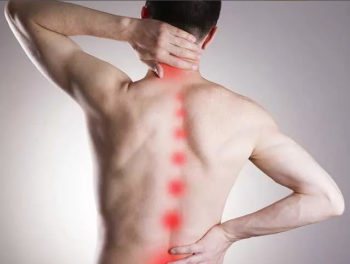
- osteochondrosis, arthrosis, hernias and other deformation processes in the chest area;
- aortic aneurysm, benign and malignant neoplasms in the pleural cavity;
- diseases of internal organs;
- physical stress;
- diabetes;
- chest injuries;
- awkward sudden movement;
- avitaminosis;
- violation of metabolic processes;
- prolonged incorrect body posture when working.
The most characteristic symptoms of neuralgia:
- periodic or non-stop pain in the ribs;
- osteochondrosis, arthrosis, hernias and other deformation processes in the chest area;
- aortic aneurysm, benign and malignant neoplasms in the pleural cavity;
- diseases of internal organs;
- physical stress;
- diabetes;
- chest injuries;
- awkward sudden movement;
- avitaminosis;
- violation of metabolic processes;
- prolonged incorrect body posture when working.
The most characteristic symptoms of neuralgia:
- periodic or non-stop pain in the ribs;
- muscle twitching;
- increased sweating;
- redness or paleness of the skin;
- increased pain when coughing and changing body position;
- pain in the lumbar region;
- fights when pressing on certain points of the thoracic spinal column;
- A feeling of numbness may occur at the site of damage to the nerve fibers.
Treatment is as follows:
- Taking medications that can only be prescribed by a doctor, based on the intensity of pain and other factors.
- Physiotherapy. Prescribed for pain relief. This can be electrophoresis, thermal procedures, amplipulse, etc.
- Vitamin therapy. B vitamins are especially indicated, since they nourish nerve fibers.
- Physical therapy to relieve muscle spasms and relax muscles.
Important! Self-medication is absolutely excluded, since medications have contraindications, and all other methods of treatment should be prescribed after the acute syndrome has resolved and carried out under the supervision of a physician.
An interesting video about intercostal neurosis - a description of the disease, and methods of treatment with a special patch.
By what signs can intercostal neuralgia be identified?
Intercostal neuralgia is compression or pinching of the thoracic nerve. These nerve endings are located in the cavities located between the ribs. Signs of intercostal neuralgia include the appearance of pain attacks in the back, chest and heart. Pain may be felt in the stomach, lower back or abdomen.
Symptoms of intercostal neuralgia
The main symptom of intercostal neuralgia is the occurrence of acute, shooting pain. Attacks of intercostal neuralgia appear due to muscle spasm while a person is in one position for a long time, during a sharp turn or squat. There are symptoms that determine the presence of neuralgia:
- burning in the chest;
- sharp pain attacks in the back, neck, sternum, intensifying during turns, breathing, bending;
- redness of the skin in the affected area;
- numbness at the site of the lesion.
At the beginning of the disease, the symptoms are less pronounced, then the attacks can intensify and become unbearable with every movement.
The causes of damage to the nerve endings in the sternum are pathologies of the spine, osteochondrosis of the thoracic region, infections, diabetes mellitus, and inflammation in the joints.
The difference between the symptoms of neuralgia and heart disease
The danger is that signs of neurosis can be confused with symptoms of damage to internal organs, such as the liver and kidneys.
Neuralgia of the intercostal region from heart disease can be recognized by some signs:
- pain during neuralgia becomes greater during inhalation and sneezing, while the heart pain from these movements does not go away and does not become stronger;
- pain syndrome due to neurosis is not relieved by Nitroglycerin, while taking cardiac medications for heart disease can relieve painful manifestations;
- when the heart is damaged, blood pressure rises and the pulse quickens; with neurosis, these indicators remain normal;
- When nerves are pinched, painful sensations appear when you press on the affected area.
The appearance of painful sensations in the chest area with intercostal neurosis occurs more often in women. In men, the lower sternum is more often affected, and pain occurs in the abdomen or stomach.
To avoid health problems, if you have prolonged pain in the chest area, behind the sternum, or increased blood pressure, you should contact a cardiologist or call emergency help.
Localization of pain in intercostal neuralgia
To reduce pain from intercostal neuralgia, modern medicine uses a number of measures aimed at suppressing pain, restoring the damaged nerve, and preventing this disease.
Local pain
Intercostal neurosis causes local pain that appears during sneezing, coughing, and sudden turns of the body. Occurs at the site of the affected nerve. In this case, redness of the skin at the affected area, burning, and numbness of the skin around the nerve ending may be observed.
Radiating pain
Radiating pain appears far from the site of the lesion. It occurs when the nerve impulse transmitting it is so high that the pain sensation goes beyond the boundaries of the lesion.
Therefore, pain syndrome due to chest neurosis can appear in the neck, lower back, and stomach.
Referred pain
Referred pain in thoracic neurosis is the most dangerous, since the foci of pain are localized in one or another part of the body remote from the affected nerve. With such pain that does not go away for several days, it is important to find out the cause of its occurrence.
Diagnosis and treatment of intercostal neuralgia
In order to determine the extent of damage to nerve endings, you need to consult a neurologist. During the examination, the doctor will palpate the affected area and perform other manipulations necessary to diagnose the disease.
The specialist will also determine where the lesion is located. In case of pain in the heart area, additional consultation with a cardiologist will be required to rule out cardiovascular pathologies.
If pain is localized in the lower part, it is necessary to exclude diseases of the liver and stomach.
To treat intercostal neurosis, a number of measures are used to relieve the affected nerve ending.
Analgesics are also prescribed to reduce pain. Treatment with medications can be supplemented with physiotherapy. Massage of the back and chest has a beneficial effect on neuralgia. Massage helps improve blood flow, increase blood supply to the affected area, and relaxes muscles.
Acupuncture and injection reflexology help well. These therapies relieve pain and help deliver medications directly to the affected area.
To get rid of chronic intercostal neuralgia, it is recommended to engage in swimming, physical therapy, avoid back and spinal injuries, and limit physical activity.
Timely seeking help from a specialist for neurosis will help avoid unpleasant symptoms and speed up the recovery process.
Source: //eustress.ru/nevroz/priznaki-mezhrebernoj-nevralgii
Neurosis of the cervical spine
Cervical neurosis develops against the background of cervical osteochondrosis; if the cervical area of the spinal column is damaged, an intervertebral hernia, impaired blood flow and pinched nerve roots can develop. In this case, the patient experiences various pain sensations that can radiate to the shoulder, back of the head, or ear. In addition, with cervical neurosis, visual acuity may decrease, and signs of vegetative-vascular dystonia may appear:
- increased blood pressure;
- fever or chills;
- insomnia;
- nausea;
- weakness.
Cervical neurosis can manifest itself as pain in the heart and lungs.
- pain in the back of the head and in the temporal region;
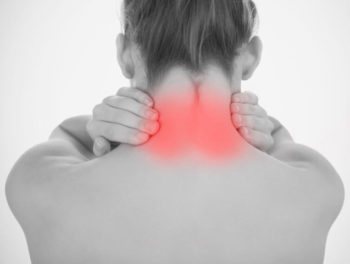
- deterioration of the sensitivity of the tongue, which leads to deterioration of speech;
- pain in the upper limbs;
- numbness of fingers;
- stiffness in hand movements;
- pain in the liver area and under the shoulder blades;
- burning in the cervical region, as well as decreased sensitivity in the neck and shoulder.
The pain with cervical neurosis is dull and bursting.
To treat cervical neurosis, medications and massage are prescribed. The duration of treatment depends on the intensity of the clinical picture and the severity of the pathology. If the disease is advanced and the patient suffers from severe pain attacks, he may be prescribed potent medications, which are available in pharmacies only with a doctor’s prescription.
We invite you to watch a short video about spasms in the muscles of the cervical spine.
Facial nerve neurosis
This is a unilateral lesion that is observed in the 7th pair of nerves located in the cranial region. These nerves regulate facial expressions on one side, so the main symptom of facial nerve neurosis is the absolute inability to control facial expressions in the affected area.
As a rule, it is impossible to determine the causes of this very unpleasant phenomenon, however, there are factors that can provoke facial paralysis:
- infectious diseases;
- atherosclerotic pathologies and other vascular diseases;
- traumatic brain injuries;
- draft and hypothermia;
- the presence of tumors in the brain;
- inflammatory processes in the facial sinuses, ears or brain;
- complications and consequences of anesthesia, which was used for dental procedures.
Facial nerve neurosis is characterized by an acute course. Clinical signs of pathology develop rapidly and can be persistent.
Visible signs of pathology:
- asymmetry of the face - the palpebral fissure on the affected side widens, skin folds are smoothed out;
- drooping lower lip;
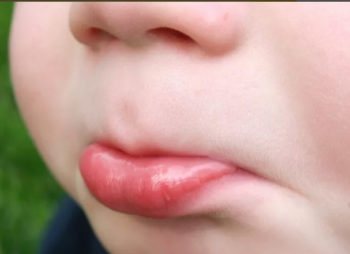
- when trying to smile, the mouth is pulled to the undamaged side;
- inability to wrinkle the forehead or raise the eyebrows;
- incomplete closure of the eyelids.
- loss of sensation in the affected area (complete or partial);
- pain, especially if there is an inflammatory process in the trigeminal nerve;
- oculomotor function disorder;
- lack of eye reflexes;
- problems while eating;
- taste disturbances;
- a painful increase in hearing function, in which any sound is heard louder and sharper than it really is. In some cases, deafness develops;
- increased tear production;
- decreased or increased salivation.
With complications of this pathology, muscle contracture is possible, which causes a sensation of paralysis of the healthy part of the face.
The sooner proper treatment of facial nerve neurosis begins, the lower the risk of complications. Therefore, you need to seek help from a doctor as quickly as possible. The doctor will prescribe:
- anti-inflammatory drugs;
- diuretics to relieve swelling;
- painkillers;
- vasodilators.
In addition, physiotherapeutic treatment is recommended, which will speed up the recovery process in the nerves. Facial gymnastics is also shown. If there is no effect from conservative treatment tactics within 10 months, surgery may be prescribed - autotransplantation of the nerve.
Prevention of muscle neuroses
Despite the fact that there are many ways to defeat neurosis and relieve muscle tension, doctors recommend trying to prevent the development of this pathology, because often the treatment of muscle neuroses is long and difficult.
To reduce the risk of muscle neurosis, you must adhere to the following principles:
- Reducing stress in everyday life.
- Proper working conditions, as well as strict adherence to work and rest schedules. In addition, during prolonged sedentary work, it is recommended to get up every hour and do simple gymnastic exercises to relieve muscle tone.
- Proper nutrition, providing the body with all the necessary vitamins and minerals.
- Active lifestyle, sufficient physical activity - walking and so on.
Water procedures are useful, and these include not only baths with essential oils, but also contrast showers. Contrast showers cope very well with a number of problems:
- nervous system disorders;
- initial stages of hypertension;
- VSD;
- low immunity and many others.
However, it is contraindicated in the following cases:
- atherosclerosis;
- tendency to bleed;
- heart failure;
- skin diseases;
- tumors;
- tuberculosis;
- menstruation.
If it is impossible to relax on your own, doctors recommend seeking help from specialists - these can be psychotherapists, yoga therapists and others. It is also a good idea to take preventative massage courses from time to time.
How to relieve muscle tension during neurosis? It is very important to understand that any remedy that is aimed at relieving muscle tension will be ineffective if a person does not relieve moral or mental stress. Therefore, the basis of preventive measures to prevent muscle neuroses should be work with the psychological state of the patient.
Muscle neuroses are painful and very unpleasant manifestations that cause a person a large amount of pain and significantly reduce the quality of life. It is not advisable to treat muscle neuroses on your own, since only a doctor can determine the cause of the disease, its nature and severity. Drugs that are used to treat muscle neuroses can be prescribed from different groups, and an independent approach to choosing a drug can only aggravate the situation.
- Proper working conditions, as well as strict adherence to work and rest schedules. In addition, during prolonged sedentary work, it is recommended to get up every hour and do simple gymnastic exercises to relieve muscle tone.
- Proper nutrition, providing the body with all the necessary vitamins and minerals.
- Active lifestyle, sufficient physical activity - walking and so on.
Water procedures are useful, and these include not only baths with essential oils, but also contrast showers. Contrast showers cope very well with a number of problems:
- nervous system disorders;
- initial stages of hypertension;
- VSD;
- low immunity and many others.
However, it is contraindicated in the following cases:
- atherosclerosis;
- tendency to bleed;
- heart failure;
- skin diseases;
- tumors;
- tuberculosis;
- menstruation.
If it is impossible to relax on your own, doctors recommend seeking help from specialists - these can be psychotherapists, yoga therapists and others. It is also a good idea to take preventative massage courses from time to time.
How to relieve muscle tension during neurosis? It is very important to understand that any remedy that is aimed at relieving muscle tension will be ineffective if a person does not relieve moral or mental stress. Therefore, the basis of preventive measures to prevent muscle neuroses should be work with the psychological state of the patient.
Muscle neuroses are painful and very unpleasant manifestations that cause a person a large amount of pain and significantly reduce the quality of life. It is not advisable to treat muscle neuroses on your own, since only a doctor can determine the cause of the disease, its nature and severity. Drugs that are used to treat muscle neuroses can be prescribed from different groups, and an independent approach to choosing a drug can only aggravate the situation.
Intercostal neurosis is compression of the intercostal nerves caused by injuries, compression injuries, inflammation, which is accompanied by acute burning or shooting pain in the ribs. The disease occurs in people of all ages, but is most common in adults.
The structure of the intercostal nerves contains sensory, motor and sympathetic fibers. The intercostal nerves form 12 pairs. They provide innervation to the chest, mammary glands, pleura (costophrenic), anterior abdominal wall, and peritoneum.
The sensory fibers of neighboring nerves connect, and thus cross innervation occurs (one area of the skin or muscle is innervated by the main nerve, as well as neighboring ones).
Diseases of the nervous system: neurasthenia, migraine, depression, radiculitis, neuritis, neuralgia
In our article today:
Diseases of the nervous system: neurasthenia, migraine, depression, radiculitis, neuritis, neuralgia
NEURASTHENIA.
Many people suffer from neurasthenia, as well as vegetative-vascular dystonia. With this disease, great importance is attached to physiotherapeutic treatment. And above all, water procedures and air baths. Foot baths in running water work well, which is easy to do in the bathroom. Gradually reduce the water temperature. Contrast baths, alternating warm, cool and cold douches, are very useful. At night, cold foot baths are recommended, followed by rubbing the feet with a dry towel.
With neurasthenia, patients often complain of headaches. Foot running baths with cold or cool water and walking in the water of such a bath are useful. In this case, you should pour cold water on your feet. But it is best to use contrast baths, alternating cold and very warm water.
As soon as these thermal and mechanical irritants (mechanical irritations are achieved by vigorous rubbing) make the legs red and hot, the face becomes pale, and headaches most often disappear. A sitz bath with a water temperature of 10-12 °C works in a similar way.
The duration of this procedure is up to three minutes. Soap and foam baths are also very useful.
For insomnia, which is typical for many people suffering from neurasthenia, self-massage and taking a warm general bath (28-30 ° C) for half an hour at night are indicated. Or just before bed, take a sitz bath (12-16 °C) for four minutes. If the patient often wakes up, then he should place a portable sitz bath near the bed and sit in it for three minutes. Get out of it without drying yourself, allowing your body to dry from the warmth of the bed. Usually after this, well covered with a blanket, the patient falls asleep. If such baths do not give the desired result, then you can use air baths, since moderate exposure to cool air has a calming effect on the nervous system. You should take an air bath while undressing. During the daytime, short sitz baths are appropriate, preferably cold ones (20-15 °C). The duration of the procedure is three minutes. Aero-aromatherapy baths will also be useful for those suffering from neurasthenia, for which it is recommended to plant certain fragrant flowers or other plants in your herbal corner, the pleasant smell of which has a positive effect on the patient. Aerophytotherapy has been considered effective in the treatment of neurasthenia since ancient times. Of course, you need to carry out general strengthening therapeutic exercises every day in the fresh and clean air (on the balcony, veranda). Traditional medicine for neurasthenia offers the following recipes:
Peony evasive.
Prepare an infusion: pour one teaspoon of dry roots with half a liter of boiling water, leave for about an hour in a warm place, then strain. Take a tablespoon several times a day twenty minutes before meals.
Valerian officinalis.
Prepare an infusion: infuse ten grams of dry crushed root in three hundred milliliters of boiling water for at least four hours. You need to take three tablespoons three times a day.
Borage grass.
This herb has long been called the herb that “makes the soul glad.” Prepare an infusion: pour one tablespoon of pre-crushed raw material with a glass of boiling water, leave for at least an hour, then strain. Take half a glass three times a day. These recipes are indicated for nervous excitement.
For nervous exhaustion, healers recommend the following remedy: pour three tablespoons of the medicinal cap with half a liter of boiling water (with sugar) and leave for half an hour. Drink like tea before meals. The daily dose is half a liter.
MIGRAINE.
Women are more likely to suffer from this disease. It is characterized by paroxysmal, mostly unilateral headaches of varying intensity, duration and frequency, which is accompanied by autonomic disorders.
Migraine headaches are usually localized in the frontotemporal region, mainly on one side, and have a pulsating character. In many patients, headache is accompanied by nausea and vomiting.
Violations of vascular tone are typical: the hands and feet become cold, the color of the face changes (usually pallor), and redness of the eyeballs is observed.
Symptoms such as chills, drowsiness, frequent urination, lack of appetite, and severe adynamia are also characteristic.
If the patient likes the cold, then he is prescribed cold foot running baths, and if it is warm, then a warm compress is applied to the head. And in the intervals between attacks of headache, cold douches are given. These procedures are accompanied by others, namely: three to four half-baths per week with lukewarm water, but with strong rubbing; in the summer months they use cool water. Lavender baths are beneficial. Otherwise, the same baths are used as in the treatment of neuroses. In addition to the treatment being taken, traditional healers recommend the following remedies:
Common oregano.
Prepare an infusion: pour a couple of tablespoons of dry herb with a glass of boiling water. Let the whole thing sit for about an hour, then strain thoroughly. Take one hundred grams three times a day half an hour before meals (preferably warm).
Lavender oil
. Diluted in alcohol, it is used to rub the temporal lobe on the side where headaches occur.
Pharmaceutical camomile.
Take two grams of dry powder an hour after meals.
spring primrose
(primrose, rams). Prepare an infusion: pour ten grams of dry crushed leaves with a glass of hot water. Let everything sit for an hour, then strain. Take seventy grams of a glass up to three times a day.
DEPRESSION
Depression (Latin depressio - oppression, depression) is a mental disorder, the main symptom of which is a depressed, depressed, melancholy mood, combined with a number of disorders of thinking, motor reactions and autonomic disorders. Patients usually strive for solitude; they experience persistent sleep and appetite disturbances. Patients constantly experience a feeling of fatigue, lethargy, and fatigue. They, as they themselves say, “can’t pull themselves together.” These patients are advised to stand in cold water up to the knee (foot baths). Carry out such procedures three times a day. The duration of each procedure is two minutes. After completing the procedure, in order to warm your legs faster, you need to do a brisk walk, then take hand baths (twice a day), putting your hands in cold water for a couple of minutes, and then warm them up with some kind of work. It is also recommended to vigorously pour cool water over the back, chest and abdomen twice a day (vinegar water is better). The course of hydrotherapy is two weeks, and according to indications, longer.
There is another option for hydrotherapy:
1)
every evening, when the patient is warm in bed, wash the whole body with water and vinegar;
2)
twice a day, a warm night bath with ash and salt for two weeks;
3)
daily, twice a day, twenty drops of wormwood tincture in water. Within three weeks there is a noticeable improvement.
Modern psychiatrists recommend general warm baths with a water temperature of 28-27 °C. The duration of the procedure is five minutes or more. A bath at 28 °C for up to two hours is especially indicated in motorically excited patients. For insomnia and depression, such a bath is very appropriate at 19-21 hours. Other bath procedures are the same as those used in the treatment of neurasthenia. To more quickly overcome depression, traditional medicine recommends the following treatment:
Medicinal gimlet.
In common parlance, this plant is called the “herb of fun”, for its ability to lift the mood and eliminate feelings of fear and melancholy. Prepare an infusion: pour a tablespoon of this herb (dry) or a teaspoon of dried flowers with a glass of boiling water, let the whole thing brew for about an hour. Take 50 grams several times a day.
Elder.
Prepare an infusion of black elderberry roots: cook one tablespoon of pre-crushed roots for twenty minutes over low heat in two hundred milliliters of water. Strain and drink the resulting medicine warm in several doses.
Coriander
(cilantro). Prepare an infusion of seeds: pour one tablespoon of pre-crushed raw materials with two glasses of hot water. Leave for one hour, then strain. Take a quarter glass four times a day.
RADICULITIS, NEURITIS, NEURALGIA
Radiculitis is a disease caused by damage to the roots of the spinal nerves. Neuritis is damage to individual peripheral nerves. Neuralgia is pain that spreads along the trunk of a nerve or its branches. All these ailments are largely similar in pain symptoms, and therefore their treatment is also largely similar. Including bath procedures.
The clinical symptoms of these neurological ailments are familiar to many: with radiculitis, this is a sharp pain in the cervicothoracic, thoracic, or sacrolumbar spine with irradiation of pain to nearby areas (neck, arms, legs, etc.) . With neuritis and neuralgia, pain is felt along the corresponding nerve trunks and their branches.
Quite often, bath treatment occurs sequentially: first, treatment is carried out with dry hot air (at home this is from a hot stove or fireplace), followed by a cooling bath (30-25 ° C) for five minutes and with a strong massage of the diseased area five hours later. after taking a bath procedure. Where the nerve is surrounded by muscles, massage and hydrotherapy baths are equally useful. But what works most effectively in these cases is electric light, say, from a table lamp with a voltage of, for example, 100-200 watts or more. Sand and mud baths on painful areas are also useful. For neuritis, thermal baths with a water temperature of 30 ° C for half an hour are indicated. Both half baths and rain showers are indicated in the recovery phase. In addition to this and other treatment methods, traditional medicine recommends the following remedies:
Apple vinegar.
It is taken five to ten teaspoons three times a day with meals (it is more useful for cervical osteochondrosis, which occurs with symptoms of radiculitis).
Horseradish.
Its freshly grated pulp is rubbed into painful areas (this significantly reduces pain). Fresh leaves can also be used for these purposes. Prepare the composition, mix two hundred grams of salt and one hundred grams of dry mustard, add the same amount of kerosene to get a mixture resembling sour cream. Rub dry onto affected areas overnight.
Poppy.
Its seed powder mixed with honey is rubbed on the affected area and this relieves pain.
Purified turpentine.
Mixed with Vaseline (1:2 ratio) it is used to rub painful areas.
Fir.
Its oil is used for rubbing.
Lavender
. Lavender oil is used for rubbing painful areas.
PS If your joints hurt or you're just tired of sitting at home, you need to rest!
Source: //medblock.ru/medicina_i_zdorovje/2227-bolezni-nervnoy-sistemy.html
Mechanism of damage and its causes
Intercostal neurosis (neuralgia) occurs due to pinching (irritation) of the nerves in the intercostal space, or as a result of pinching of the spinal nerve root. The roots are pinched due to manifestations of osteochondrosis, as well as due to ankylosing spondylitis and ankylosing spondylitis.
The intercostal muscles impinge on the nerve as a result of existing muscle spasm or inflammation, and thus cause irritation of the nerve. Muscle spasms can be caused by psychological stress, traumatic exposure, or excessive physical activity.
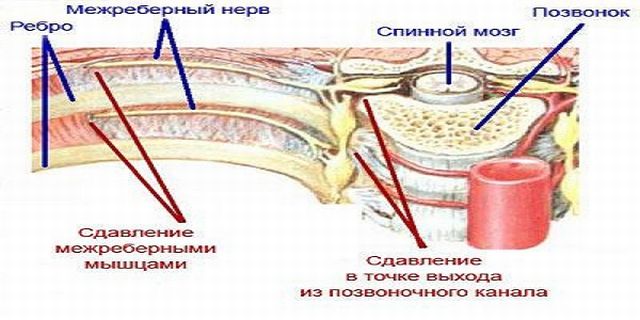
Inflammation and spasm of the intercostal muscles can also occur due to previous infections, hypothermia, and lung diseases.
The causes of the development of intercostal neurosis also include:
- poisoning;
- changes in the spine caused by hormonal changes during menopause;
- polyradiculoneuritis;
- multiple sclerosis;
- allergic diseases;
- osteochondrosis, arthrosis, spinal curvature, chest deformation, intervertebral hernia, thoracic spondylosis;
- aortic aneurysm, benign pleural tumor, chest wall neoplasms (chondrosarcoma, lipoma, rhabdomyoma, chondroma, osteoma);
- herpes infection;
- diseases of internal organs;
- microtraumas due to regular physical stress;
- diabetes;
- chest injuries, rib fractures, spinal injuries;
- excessive alcohol consumption;
- sudden movements;
- lack of B vitamins;
- metabolic disorders in nerve tissues;
- incorrect working position.
Neuralgia as a secondary symptom
Intercostal neuralgia is classified depending on the cause of its occurrence. The disease is not independent and develops as a complication of a number of pathologies.
Neuralgia is distinguished against the background of:
- rib deformations;
- changes in the structure of the vertebrae;
- irritation of the spinal nerve roots.
Deformation of the ribs includes trauma, fracture and the presence of a neoplasm. All this leads to a pinched nerve.
Often pinched intercostal nerves are associated with changes in the vertebrae. In this case, pinching occurs due to a violation of the normal distribution of body load on the spinal column. Such neuralgia can be caused by osteochondrosis of any part of the spine, back injuries and hernia.
Irritation of the spinal nerve roots is provoked by an infectious lesion, and pain can be felt between the ribs. In this case, the cause of neuralgia is the presence of a focus of infection.
In the above cases, neuralgia may return again if the underlying disease is not treated.
Clinical picture and correct diagnosis
Intercostal neurosis has characteristic symptoms that make it possible to distinguish it from heart pain, with which it is often confused:
- permanent or periodic pain in the costal area (dull or sharp);
- redness, paleness of the skin, muscle twitching, increased sweating;
- intensification of pain when coughing, sneezing, sudden changes in body position;
- pain in the shoulder blades and lower back;
- pain when palpating certain points of the thoracic spine;
- numbness of tissue at the site of damage to nerve fibers.
Symptoms of intercostal neuralgia are similar to signs of cardiac, pulmonary pathologies, and stomach diseases. An accurate diagnosis must be made by a doctor, since only a specialist can distinguish pain in these diseases.
Pain due to cardiac pathologies is moderate, has a compressive nature, and disappears after taking coronary dilators. With movements, changes in body position, and uncomfortable positions, such pain does not become stronger.
Pain in neurosis is constant and becomes more intense with movement, touching, incorrect body position, sneezing, coughing. Taking painkillers and other medications does not relieve pain.
Neuralgia of the lower intercostal nerves may be similar in pain to diseases of the stomach (peptic ulcer, gastritis), diseases of the pancreas, namely pancreatitis.
With stomach diseases, the pain attack is less severe and longer lasting, and is often caused by food intake. Pancreatitis is characterized by girdling pain on both sides, which also occurs after eating.
To differentiate the disease, the gastrointestinal tract is examined: gastroscopy, determination of pancreatic enzymes in the blood.
Intercostal neurosis can occur as a symptom of thoracic radiculitis. In this case, painful attacks are combined with constant dull pain in the back, which decreases after taking a horizontal position. The condition of the spine is examined using thoracic radiography. If a herniated disc is suspected, magnetic resonance imaging of the spine is performed.
Intercostal neuralgia also occurs as a symptom of lung diseases (lung cancer, pleurisy, atypical pneumonia). If these diseases are suspected, a chest x-ray and computed tomography are prescribed.
Symptoms of pathology
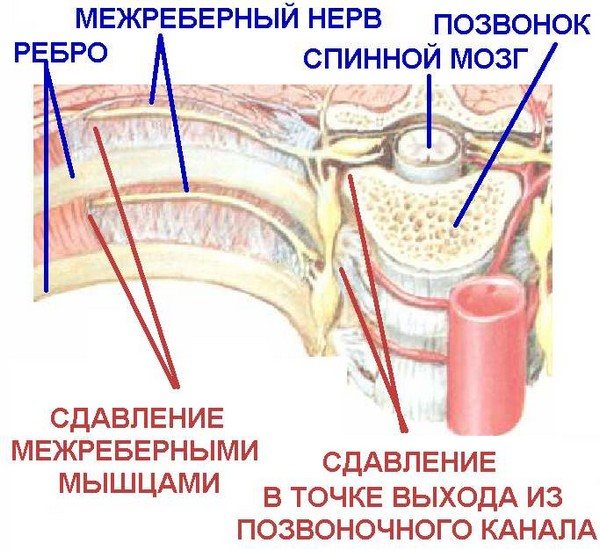
Intercostal neurosis is characterized by the following symptoms:
- sharp pain between the ribs on any side of the body;
- increased discomfort when coughing, sneezing, turning the body;
- voluntary muscle twitching;
- numbness in the area around the affected nerve.
Often such neuralgia causes pain in the lower back or thoracic spine. Pain may also be felt under the shoulder blade.
Usually the discomfort is paroxysmal in nature. The pain intensifies and then subsides. If you press on several points located in the thoracic region, the pain will intensify significantly.
Often when a nerve is pinched on the left, the symptoms are much like pain in the heart area. The patient begins to fear for his health, which results in stress and increased pain against this background.
Providing medical care
When treating intercostal neurosis, complex therapy is used, the purpose of which is to eliminate symptomatic pain, restore the nerve, and treat the primary disease that provoked neuralgia. Treatment can be either conservative or surgical. Surgical methods include decompressive neuroplasty and radiofrequency denervation.
Let's consider the main directions in the treatment of the disease.
For inflammatory processes in nerve endings, Nimesulide, Diclofenac, Nurofen, and Piroxicam are prescribed. Pain syndrome may
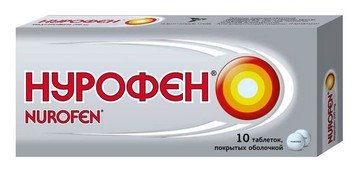
removed using injections, blockades (anaesthetics and glucocorticosteroids).
For muscle spasms, muscle relaxants are used (Balkofen, Sirdalud, Mydocalm). Sedatives are also prescribed to reduce the intensity of pain. For atypical pain in the chest area, radiofrequency destruction of the stellate ganglion is used.
Neuropathic pain is relieved using radiofrequency neuromodulation of the spinal roots. The use of B vitamins will strengthen the nervous system.
The direction of therapy depends on the underlying cause of neuralgia:
- herpes zoster - antiviral drugs (Gerpevir, Acyclovir, Famciclovir), antihistamines, antiherpetic ointments;
- muscle-tonic syndrome - muscle relaxants (Mydocalm, Tizanidine);
- osteochondrosis, vertebral displacement - dry traction of the spine, manual therapy (to relieve compression of the intercostal nerve);
- spinal pathologies, myelopathy, radiculopathy - steroid injections into the epidural space;
- tumors – surgical methods of treatment.
Physiotherapy is used for arthropathy, spondyloarthrosis, strangulation:
- magnetic therapy;
- electrophoresis using novocaine;
- amplipulse;
- thermal procedures;
- UHF therapy;
- ultraphonophoresis;
- reflexology.
Oriental medicine methods are also often used: moxotherapy, acupuncture, acupressure, hot stones, hirudotherapy.
Neurotropic treatment is also used:
- injections of B vitamins
- injections of ascorbic acid;
Treatment methods

For pain between the ribs, treatment involves:
- pain reduction;
- relieving muscle spasms;
- improvement of local blood circulation;
- strengthening the nervous system.
To reduce pain, it is necessary to take non-steroidal anti-inflammatory drugs. If such medications do not help, a blockade is performed. It does not cure the disease, and lasts for several days, after which the pain will return if the muscle spasm is not relieved.
To normalize muscle tone, taking muscle relaxants or anticonvulsants is indicated.
If it is necessary to improve local blood circulation, vasodilators are used.
Treatment must be supplemented with the intake of B vitamins, which strengthen nerve fibers and improve their metabolic processes.
Disease Prevention
Intercostal neurosis can be prevented by treating emerging problems, diseases of the spine and preventing its curvature, timely treatment of injuries in the chest area.
Increasing the level of immunity will help to avoid herpes infection, which provokes neuralgia.
This can be achieved through sports, adequate physical activity, hardening, and a healthy lifestyle.
As a preventive measure, you should also reduce the amount of stress, reduce alcohol consumption, and normalize the level of physical activity.
Preventive measures
To prevent neuralgia under the scapula, it is important to learn to listen to the signals of the body. For prevention purposes, it is recommended to adhere to certain rules:
- avoid hypothermia;
- give moderate stress to the muscles;
- monitor your posture in any position;
- do gymnastics regularly;
- adjust your diet.
Warm-up can be done in the morning and evening for 20-30 minutes. Swimming is suitable for these purposes. Those who are accustomed to heavy physical activity need to learn to take breaks for rest. This will help avoid pinched nerve endings and muscle inflammation.
